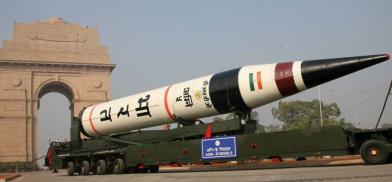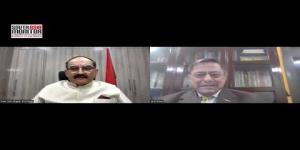Revival of nuclear posturing: Isnt it time for India to review its no-first-use policy?
China, Pakistan and Russia have clearly and unequivocally declared that they will exercise ‘FIRST USE OF NUKES’ option under certain circumstances. For China and Pakistan, India is the target. Yet our Chief of Defence Staff and premier think tank viz Centre for Air Power Studies, IDSA, USI and many others continue to ‘sing’ the outdated NFU policy.

Cold War was at its peak. Gary Powers, USAF U-2 pilot, was in custody of the USSR after his U-2 was shot down on 1st May, 1960 about the same time when the May Day parade in Moscow’s Red Square was unfolding. The JFK presidency was one of the most testing times for the entire world. The Bay of Pigs crisis in 1963 brought the world on the precipice of a nuclear holocaust.
While JFK was deliberating the available options with his advisors, nearly unanimous advice to JFK was to exercise the USA's nuclear option. Kennedy declined and resolved the crisis through dialogue with Nikita Khrushchev. The USSR pulled out its nuclear missiles from Cuba and the USA pulled out from Turkey. The world started breathing again.
But the nuclear proliferation reappeared in 1964 when China exploded its first nuclear device. The world has never been the same again notwithstanding various treaties viz NPT, CTBT, SALT, START etc. From three nuclear nations in 1964, the world has nearly a dozen recognized and so-called ‘unrecognised’ nuclear powers.
Devastation caused by two nuclear devices in Japan ‘forced’ the superpowers to start advocating NO FIRST USE POLICY (NFU) of nukes, while continuing to produce megaton nukes and developing ICBMs of over 10,000 km range.
NFU; A phrase with ulterior motive?
The phrase NFU clearly indicates that the option of use of nukes was open after having absorbed the pre-emptive strike. Hence global outpouring by leaders of all nations that nukes must not be used is a hoax. The campaign that started after Hiroshima and Nagasaki were destroyed was to BAN USE OF NUKES. But the superpowers adopted a hypocritical approach and have been the catalyst for proliferation of nukes. While they continued to amass thousands of nuclear warheads, hundreds of delivery systems and called it TRIAD, which consisted of Manned Bombers, Surface Based Ballistic Missiles and Submarine Launched Ballistic Missiles.
Revival of Cold War nuclear posturing
Nuclear-capable and fully-armed nuclear bombers were on 24-hour alert in the US. President George Bush issued a presidential decree on 27th September, 1991, which discontinued the Manned Nuclear Bomber Alert, which had continued for 12,414 days (nearly 34 years) without a break. During a recently held seminar at the USAF Strategic Command, it was proposed to reconsider commencing 24-hour alert. Evolving global instability resulting in formation of the China-Russia-North Korea axis has forced the US to reconsider its rapid response capability (RRC), which would enable it to launch limited nuclear strikes in future.
The USAF nuclear-capable bomber fleet has shrunk. Presently, the USAF has only 46 nuclear-capable B-52s and 19 B-2s. In the present ‘non-alert’ status USAF bombers will require a few days, maybe longer, to reach 24-hour alert status. Two remaining part of TRIAD can be brought to operational readiness within hours. The US is reviewing its decision to remove manned bombers from 24-hour alert.
Prevailing situation in Indian Subcontinent
India’s major adversaries China, Pakistan are nuclear weapon states having formidable and proven launch vehicles - missiles. While Pakistan has no nuclear bomber it has nuclear=capable fighters but China has dedicated nuclear bombers as well. However it is extremely unlikely that China will use manned bombers. Medium and long range ballistic missiles would be the most favoured option.
China, Pakistan and Russia have clearly and unequivocally declared that they will exercise the ‘FIRST USE OF NUKES’ option under certain circumstances. For China and Pakistan, India is the target. Yet our Chief of Defence Staff and premier think tank viz Centre for Air Power Studies, IDSA, USI and many others continue to ‘sing’ the outdated NFU policy.
China’s advances in the field of nuclear weapons development and deployment is astonishing during the past decade. China is headed to possess nearly 1000 warheads before the end of this decade. Construction of hundreds of silos and acquisition of new nuclear submarines are being undertaken on priority. It might be construed that these developments are aimed to counter the US but does it prevent China from looking southward?
Instability in Bangladesh would almost certainly result in enhancement of Chinese investments and military presence. Increased Chinese military presence in Bangladesh will change the security matrix for India adversely. It can only be countered by muscle flexing by India.
Are our decision makers blind to these developments taking place with amazing regularity and speed? Without going into the details of how nuclear-tipped missiles are launched and how much time it takes to launch from the ‘go-ahead’, suffice to say that it does not happen in hours.
Since we have been aping the West while formulating our defence policies (offensive/pre-emptive), why don’t we continue to do the same in case of use of nukes? Two P-5 nations (China, Russia) have unequivocally announced their intent of ‘FIRST USE’. Pakistan is even more candid and vocal when its authorities clearly state that their nuclear weapons programme is aimed at India and it will have no hesitation in using nukes against India, population centres included. The US is reviewing its alert status of manned nuclear bombers but we are stuck with our tail between our legs.
When will we wake up and review our utterly flawed NFU policy?
(The writer is a former Director, India's Ministry of Defence, retired fighter pilot, author and columnist on national security, geostrategic and military issues. Views are personal. He can be reached at tps_in@yahoo.com)










Post a Comment